In a million years, you'll likely encounter a version of humans shaped by countless factors. Our physical form may evolve due to environmental pressures, featuring altered bone density and height. Technological augmentation could lead to cyborg-like beings, blending biology and tech for enhanced cognitive functions. Genetic diversity will flourish, particularly in urban areas where adaptation is essential. As climate changes, you'll see humans developing new survival strategies. The interplay of societal norms, ethical considerations, and advanced knowledge will redefine what it means to be human. If you keep exploring, you'll uncover more intriguing possibilities about our future selves.
Essential Insights
- Humans may develop enhanced physical traits, such as increased height and bone density, due to ongoing environmental adaptations.
- Genetic diversity will shape urban populations, leading to unique adaptations and traits in response to diverse challenges.
- Technological integration may result in cyborg-like beings, merging biological and artificial enhancements for improved cognitive and physical abilities.
- Climate change will drive evolutionary adaptations, necessitating new strategies for survival that blend genetics and cultural innovations.
- Ethical considerations will influence human identity, as societal norms evolve around augmented and unaugmented individuals in future communities.
Physical Adaptations Over Millennia

Over the millennia, humans have undergone significant physical adaptations in response to environmental pressures. One of the most notable changes is bipedalism evolution, which allowed you to walk upright. This adaptation not only freed your hands for tool use but also led to skeletal modifications in your pelvis, legs, and spinal structure. As a result, you now have a unique body designed for endurance and efficiency.
During this time, brain size changes played a vital role in your development. An increase in brain size, especially between 800,000 and 200,000 years ago, enabled complex thought processes and better adaptation to shifting climates. Additionally, the development of increased brain size facilitated advancements in social learning and language, further enhancing human cooperation.
Furthermore, dietary adaptations emerged as you learned to digest starches and dairy, which were essential for survival. Your muscle distribution also evolved to support these adaptations. Changes in muscle mass and strength helped improve your ability to run and navigate various terrains.
In addition, these adaptations contributed to disease resistance, allowing you to thrive in densely populated environments. Looking toward the future morphology of humans, predictions suggest that as you continue to face new challenges, further adaptations will occur.
For instance, you might see changes in bone density or even shifts in height as a response to different environmental conditions. Ultimately, these physical adaptations showcase humanity's resilience and ability to thrive amidst ever-changing landscapes.
Impact of Technology on Evolution
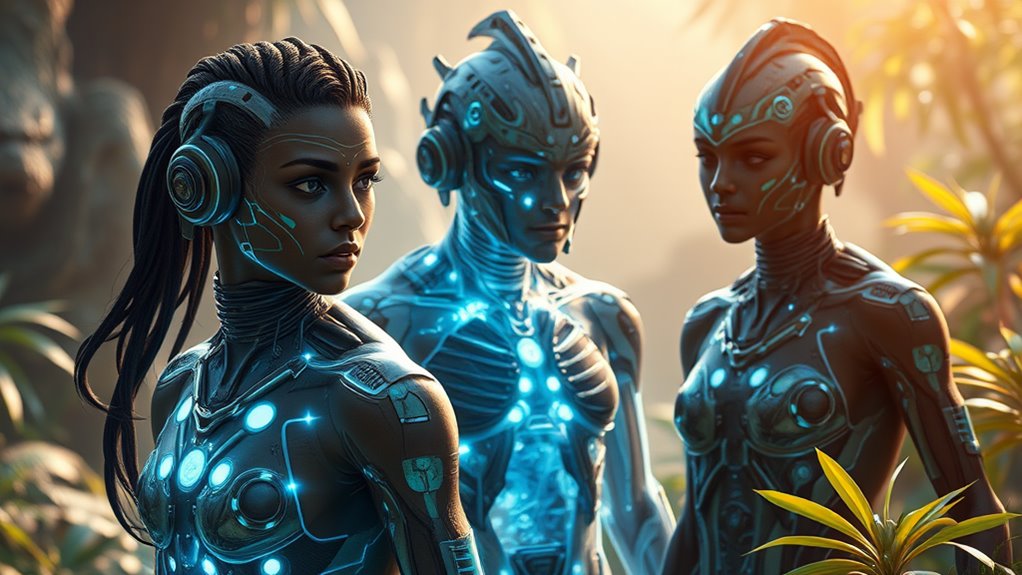
As humans continue to adapt physically, technology increasingly shapes our cognitive processes and biological evolution. You're witnessing a shift where information access transforms decision-making, moving from instinct-based choices to data-informed ones. This change in cognitive evolution allows you to process vast amounts of information quickly, enhancing your ability to solve complex problems through algorithmic thinking. Moreover, this reliance on technology has been linked to reduced attention spans, impacting how you focus on tasks and engage in meaningful conversations.
Advanced technologies like brain-computer interfaces (BCIs) and neuroprostheses are set to redefine your cognitive functions. Imagine connecting your mind directly to information resources, enabling instantaneous knowledge retrieval. This technological symbiosis not only amplifies your cognitive abilities but also fosters rapid learning and adaptation, allowing you to keep pace with an ever-evolving world.
Moreover, biotechnology is paving the way for medical advancements that greatly impact human health and longevity. Techniques like CRISPR-Cas9 allow for precise genetic modifications, enhancing disease resistance and potentially altering the genetic landscape of future generations.
With the integration of wearables and health monitors, you're becoming more aware of your health, leading to improved outcomes.
As technology continues to merge with biology, you'll likely see a future where prosthetics, bionic implants, and cognitive enhancements become commonplace. This fusion could result in cyborg-like beings, with neural links and augmented capabilities.
Ultimately, the interplay between technology and biology won't just change how you live but will redefine what it means to be human in a million years.
Environmental Factors Shaping Humanity

Environmental factors have played an essential role in shaping humanity's evolution, driving adaptations that have enabled survival through fluctuating conditions. Over millions of years, climate variability has acted as a powerful environmental trigger, leading to habitat shifts and resource scarcity. These changes imposed ecological pressures on early humans, favoring adaptive traits that enhanced climate resilience and survival strategies.
As you consider how these factors influenced human evolution, take a look at the table below, which summarizes key environmental influences and their effects on humanity:
| Environmental Factor | Impact on Humanity | Adaptive Traits Developed |
|---|---|---|
| Climate Variability | Droughts led to resource scarcity | Larger brains, tool-making skills |
| Habitat Shifts | Emergence of new species | Versatile teeth for varied diets |
| Ecological Pressures | Competition for resources | Enhanced social cooperation |
| Resource Availability | Influenced migration patterns | Greater adaptability to environments |
The dramatic changes in climate have forced humans to develop evolutionary advantages, such as increased cognitive abilities and social behaviors. These traits helped our ancestors navigate challenges posed by their environments. Understanding these environmental factors not only sheds light on our past but also provides insights into how future climate changes may shape humanity. Climate changes are linked to major evolutionary milestones, suggesting that ongoing environmental pressures could drive new adaptations, evolving humanity in ways we may not yet imagine. As you explore this topic, consider how continued environmental pressures could drive new adaptations, evolving humanity in ways we may not yet imagine.
Genetic Diversity in Future Generations
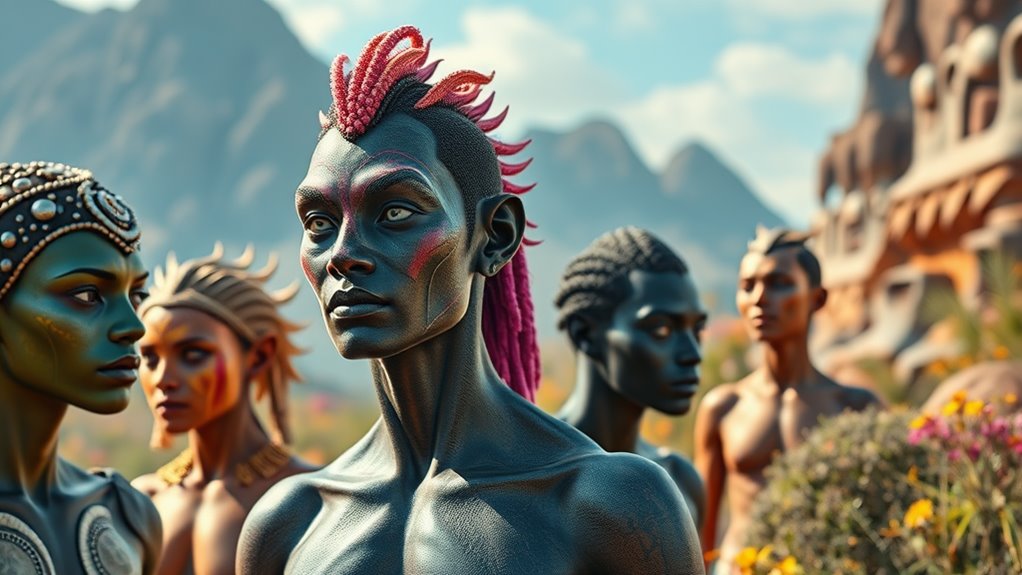
Genetic diversity is set to flourish in future generations, particularly in urban areas where migration from rural regions increases. As people move into cities, they bring with them unique ancestral traits, contributing to a melting pot of genetic variation. This urban evolution fosters a dynamic environment where diverse migration patterns enhance genetic resilience, allowing populations to adapt better to changing conditions. Moreover, the constant influx of newcomers may lead to an acceleration in genetic mutations, further enriching the urban genetic landscape.
In contrast, rural areas are expected to retain more ancestral genes, leading to less genetic diversity. This divergence between urban and rural genetics will shape future human identity, driving the fusion of different genetic backgrounds. As populations in Africa expand rapidly, their genetic frequency will influence global diversity, promoting darker skin tones as lighter-skinned populations reproduce at lower rates.
New mutations, occurring at a staggering rate in the human genome, will further enrich this genetic landscape. Each year, approximately two new mutations arise for every 3.5 billion base pairs, adding layers of variation that can be significant in certain populations. High-quality sequencing technologies reveal millions of previously unknown DNA variations tied to specific geographical regions, highlighting the intricate tapestry of human genetics.
As genetic engineering becomes more prevalent, the ability to select desirable traits will likely accelerate this process. You might witness a world where genetic fusion not only enhances physical attributes but also improves health outcomes.
Together, these factors will create a vibrant, genetically diverse future, reflecting the complex interplay of migration, adaptation, and technological advancement.
Lifespan Changes and Implications
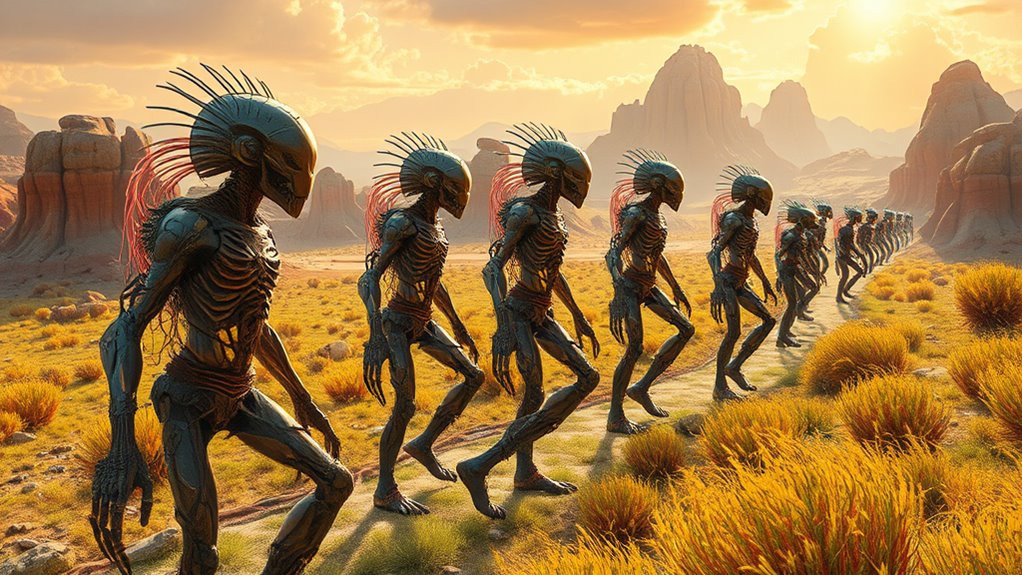
The future of humanity's lifespan promises remarkable changes, as advancements in healthcare and technology push average lifespans toward or beyond 100 years. With reduced mortality rates and groundbreaking medical innovations, you're likely to experience longevity benefits that were once thought impossible.
Imagine living not just longer, but healthier, with age-related diseases becoming a rarity due to regenerative medicine and genetic advancements. Furthermore, the trend toward an increased average lifespan reflects ongoing interactions between biology and modern life, influenced by technological and cultural environments.
As lifespans extend, you'll find that reproductive timing shifts considerably. With less pressure to reproduce early, many individuals will likely delay sexual maturity, allowing for longer reproductive periods. This change can lead to a more thoughtful approach to family planning, where you can focus on personal development and career before starting a family.
Moreover, an extended lifespan allows for increased genetic contribution. You'll have the opportunity to pass on advantageous traits that promote both longevity and health, ensuring future generations are better adapted to thrive. As humanity evolves, these traits may become more prevalent, leading to a population that can resist diseases and adapt to changing environments.
In this new world, the implications of a longer life will extend beyond personal benefits. Societal structures, such as retirement and healthcare systems, will need to adapt to accommodate a population that may live well into their second century.
Embracing these changes will be essential as you navigate a future where longevity isn't just a dream but a reality.
Enhancements in Human Intelligence

Increasingly, advancements in technology and neuroscience are set to revolutionize human intelligence, making it possible to enhance cognitive abilities in ways previously unimaginable. Neural enhancements, particularly through brain-computer interfaces (BCIs), are paving the way for significant cognitive evolution.
With companies like Neuralink developing advanced brain-machine interfaces, the potential for direct communication between your brain and external devices is closer than ever. This brain-machine synergy could lead to intelligence amplification, allowing you to pilot robotic exoskeletons or even experience new data streams seamlessly. Recent surveys indicate that 56% view brain chip implants negatively, reflecting public skepticism about this technology despite its potential benefits.
The impact of neurotechnology on cognitive performance is profound. Clinical trials for brain chips aimed at memory enhancement and cognitive function improvements are on the horizon. Imagine having perfect memory and the ability to learn at unprecedented rates.
The integration of AI into your brain could reveal super intelligence potential, merging human creativity with machine efficiency. Moreover, advances in genetic modifications could complement these neural enhancements. By utilizing gene editing technologies like CRISPR, you could potentially adapt your cognitive abilities to different environments, further enhancing your intelligence.
As neurotechnology continues to evolve, the possibilities for cognitive augmentation become limitless. In a future where memory enhancement and brain modifications are commonplace, the way you think, learn, and create could undergo a transformation, redefining what it means to be human.
Prepare for a future where your cognitive capabilities aren't just natural but enhanced, leading to a new era of human intelligence.
Cybernetic and AI Integration
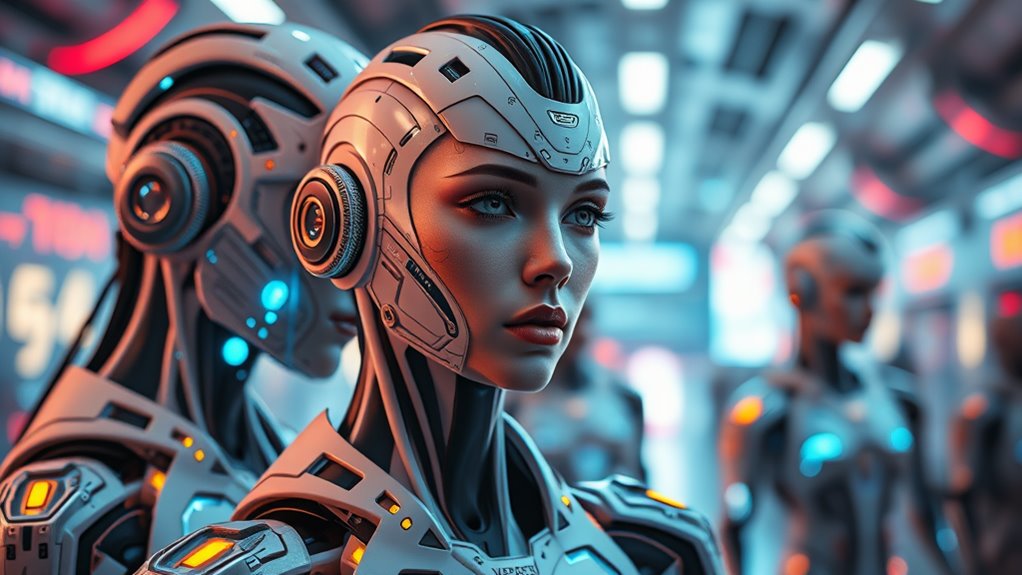
In a world where technology and biology converge, cybernetic and AI integration is transforming the human experience. As you navigate this new reality, you'll witness remarkable advancements that enhance your physical abilities and cognitive functions.
Cybernetic enhancements, from advanced prosthetics to brain-computer interfaces, are becoming commonplace, but they also raise critical cybernetic ethics discussions.
Here are some key aspects to reflect upon:
- Prosthetics and Limbs: Neural-controlled limbs enable natural movement, enhancing mobility.
- AI-Controlled Enhancements: AI-driven tools provide real-time data, making your decision-making faster and more informed.
- Sensory Enhancements: Implants like artificial corneas expand your vision beyond natural limits.
- Brain-Computer Interfaces: Direct communication with AI systems opens doors to new learning opportunities.
- Ethical Considerations: The blending of humanity with technology prompts deep questions about identity and morality.
As these technologies integrate into daily life, you'll find yourself reevaluating what it means to be human. The potential for enhanced capabilities is thrilling, yet it brings forth societal and ethical implications.
Concerns about equity in access, the definition of normalcy, and the risks of dependency on AI must be addressed.
With the rapid evolution of cybernetic and AI integration, you're part of a pioneering generation, but you'll need to engage in discussions about cybernetic ethics to guarantee a balanced future.
Embracing these advancements while critically evaluating their impacts will shape the human experience for generations to come.
Space Colonization Effects on Physiology
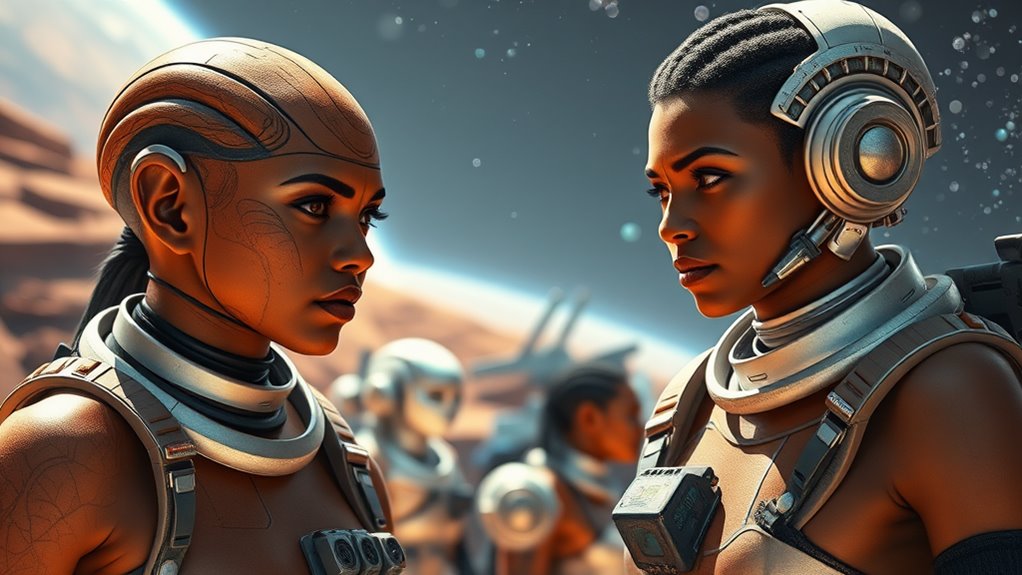
Many scientists believe that space colonization will profoundly affect human physiology in ways we're just beginning to understand. Living in microgravity exposes you to substantial physiological changes that could alter your very makeup.
For instance, you'd likely experience bone density loss, losing 1 to 2% of your bone mass each month. The lower vertebrae, hip, and femur area are especially vulnerable, making bones weaker and more prone to fractures.
Muscle atrophy is another concern. Prolonged exposure to microgravity means your lower body muscles would deteriorate due to a lack of mechanical load. This deterioration can lead to reduced cardiovascular function, with your heart rate and aerobic capacity potentially declining.
The fluid redistribution you'd face could result in facial congestion, often referred to as "moon-face," while affecting your balance and vision.
Radiation exposure is another risk factor that can greatly impair your immune system. With extended spaceflight, T-cells may struggle to reproduce and combat infections, leaving you more vulnerable to diseases.
This immune deficiency, compounded by chromosomal damage in lymphocytes, could make infections spread rapidly among crew members.
As you consider long-term health in space, these factors become critical. Adapting to life beyond Earth involves not just the challenge of living in a new environment but also managing the complex physiological changes that could redefine what it means to be human.
Climate Adaptation Strategies

Adapting to climate change requires a multifaceted approach that blends genetic evolution with cultural innovation. You'll find that while genetic changes occur slowly, cultural adaptations happen more quickly and flexibly. This means that our ability to respond to shifting climates relies heavily on our cultural resilience and adaptive innovations.
Here are some strategies humans might utilize:
- Technological advancements: Developing new building materials and infrastructure suited for changing climates.
- Agricultural shifts: Planting crops that can thrive in altered environmental conditions.
- Behavioral changes: Relocating to higher ground to escape rising sea levels.
- Resource management: Innovating ways to share knowledge and tools for survival.
- Financial investment: Committing resources to research and technology that promote adaptation.
Our ancestors thrived in unstable conditions by employing these strategies, illustrating the importance of both genetics and culture in survival.
As we face future climate disruptions, the need for adaptive innovations will only intensify. Cybernetic enhancements and genetic editing may emerge as viable options, allowing us to adapt more readily to new environments, whether on Earth or beyond.
Ultimately, the interplay of genetic evolution and cultural adaptation will shape the future of humanity. By embracing technological breakthroughs alongside time-tested cultural practices, you can help guarantee that humans not only survive but thrive in the face of climate change.
Urban-Rural Genetic Differences
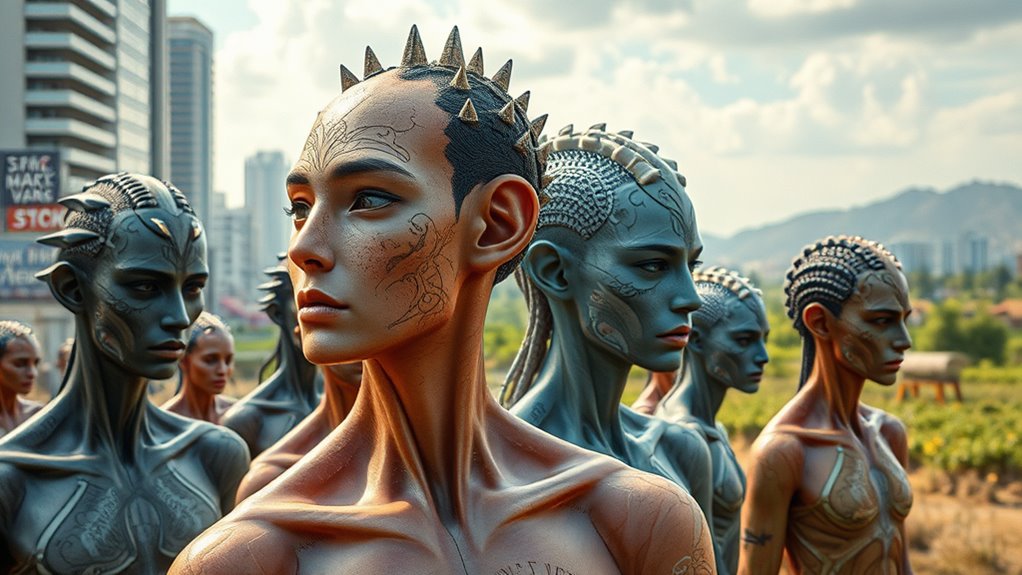
As urbanization continues to reshape human landscapes, genetic differences between urban and rural populations become increasingly evident. Urban migration often leads to genetic drift, as city dwellers may represent a limited subset of the genetic variation found in their rural ancestors.
You'll notice that rural areas tend to have a more stable genetic makeup, often characterized by long-standing rural ancestry. This isolation can contribute to lower genetic diversity compared to the dynamic and diverse urban populations.
In cities, the influx of migrants boosts genetic diversity, allowing for greater urban adaptation to various environmental challenges. Conversely, rural isolation can dampen genetic diversity and limit gene flow, making rural populations more susceptible to specific health disparities.
Urban health tends to benefit from the mixing of diverse genes, but it also faces challenges like higher exposure to pollutants and stressors.
The migration patterns from rural to urban settings further complicate these dynamics. While urban areas may gain genetic variation, rural populations experience a decline, leading to potential health consequences.
For instance, health outcomes related to BMI and heart conditions show significant variation between the two settings, with rural populations often exhibiting higher morbidity rates.
The Role of Artificial Selection
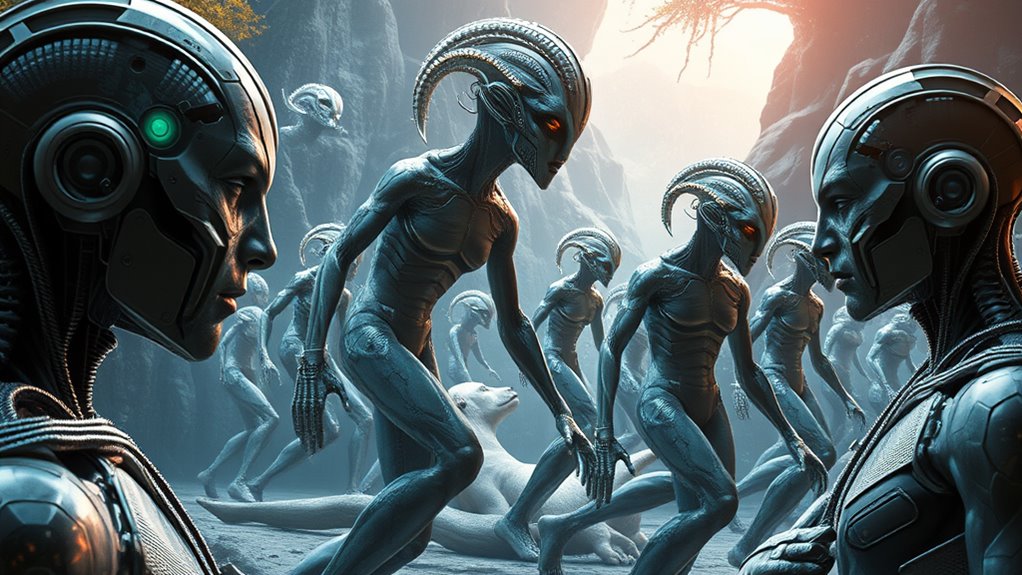
- Trait Selection: Parents may choose desirable characteristics, from eye color to disease resistance.
- Ethical Implications: Manipulating genes raises significant moral questions about what it means to be human.
- Reproductive Choices: You could opt for genetic modifications during conception to engineer healthier offspring.
- Population Genetics: These advancements will influence the genetic makeup of future generations, potentially accelerating artificial evolution.
- Cultural Influences: Societal norms and values will shape how these technologies are embraced or rejected.
As you navigate these new landscapes, health advancements could lead to longer, healthier lives.
However, you might also face dilemmas regarding the unequal access to these technologies.
The integration of technology into human biology could reshape not just your body, but also your identity.
In this ongoing evolution, the line between natural and artificial becomes increasingly blurred, raising questions about who you're and what future generations will become.
Societal Changes and Cooperation
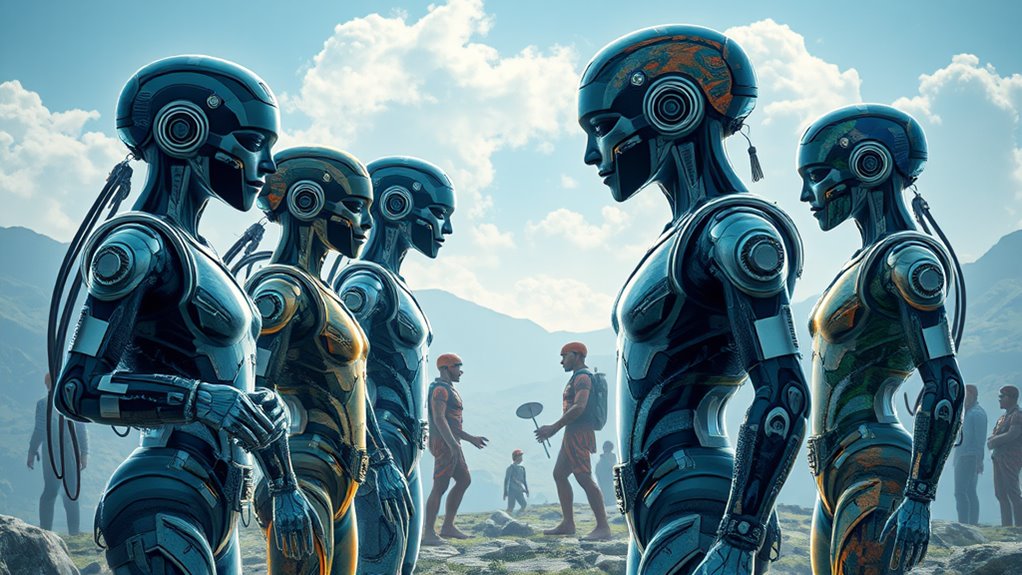
The advancements in artificial selection and genetic modification will inevitably influence societal structures and interactions. You'll witness a transformation in social dynamics as increased genetic diversity reshapes communities. In urban centers, diverse populations will foster adaptive cooperation, while rural regions may experience a decline in genetic variation due to migration patterns.
| Factor | Impact on Society |
|---|---|
| Genetic Diversity | Enhanced cooperative evolution |
| Technology Integration | New communication strategies |
| Kin Selection | Increased altruistic behaviors |
| Cultural Influences | Shaping social networks and group selection |
As humans become more reliant on technology, you'll see how AI integration alters communication strategies and influences cooperative behaviors. Frequency dependence in social interactions will lead to the evolution of traits that enhance social responsiveness. Kin selection will further encourage altruistic behaviors, reinforcing bonds within social networks.
Moreover, behavioral ecology will reveal how adaptive cooperation arises from changing environments and selective pressures. As mortality rates decrease, you're likely to observe a shift towards less aggressive, more agreeable interactions, resulting in a society that values collaboration over competition.
In a world where cooperation is paramount, the future of humanity will hinge on how well individuals navigate these social networks. You'll find that the interplay of genetic diversity, technology, and cultural influences shapes not only your physical traits but also the very essence of human relationships.
Energy Sources for Advanced Civilizations

Imagine a future where humanity taps into the vast energy resources of its planet, star, and even galaxy. As you envision this, reflect on how advancements in technology and energy policies will shape your civilization's energy landscape.
You'll witness a transformation in energy consumption, moving from finite resources to a more sustainable future that prioritizes renewable energy sources.
Here are some key aspects to reflect on:
- Energy Efficiency: Innovations will allow you to maximize energy usage, minimizing waste.
- Energy Storage: Advanced systems will capture and store energy for consistent access, ensuring energy accessibility for all.
- Ecological Impacts: Your civilization will prioritize ecological balance, aligning energy production with environmental health.
- Technological Advancements: Emerging technologies, like Dyson spheres, will revolutionize how you harness energy from stars and beyond.
- Energy Innovations: From black hole energy harvesting to bioengineered energy solutions, the future holds endless possibilities.
As you explore this future, the journey toward energy sustainability will evolve.
You'll move from harnessing the energy of your planet to mastering stellar energy and eventually galactic energy. Each step will demand a commitment to energy efficiency and the development of new energy storage methods, ensuring your civilization's growth doesn't compromise the ecological integrity of your surroundings.
Ultimately, the path you'll take reflects a deep understanding of energy consumption and the responsibility that comes with it. Your advancements won't only redefine energy sources but also shape the very fabric of your civilization.
Future of Human Body Modifications

As humanity strides into the future, body modifications will redefine what it means to be human. You'll witness a shift where prosthetics and artificial organs become commonplace, replacing and even surpassing natural body parts. Imagine having brain implants that enhance your cognitive abilities or smart contact lenses that provide augmented vision. This technological integration will push you to reconsider the boundaries of human capability.
However, with these advancements come ethical considerations. A new class system may emerge, differentiating those with extensive modifications from those who remain unaugmented. This stratification could spark debates about societal acceptance and what it means to be "normal." You might find yourself grappling with mixed feelings about augmented individuals, especially in conservative circles that may stigmatize enhancements.
Aesthetic preferences will also play a crucial role in how body modifications evolve. Some might choose to alter their physical appearance to fit new ideals of beauty, creating a culture where longer limbs and advanced features are celebrated. Meanwhile, others might resist such changes, preferring a more natural look, leading to a clash of values.
As you navigate this landscape, consider the implications of privacy and surveillance, especially with RFID chips and brain implants. Your thoughts might become accessible to others, raising questions about personal autonomy.
Ultimately, the future of body modifications will challenge your perceptions of identity, ethics, and human connection, forcing you to rethink the essence of what it means to be human.
Frequently Asked Questions
How Will Cultural Differences Influence Future Human Evolution?
Cultural differences will greatly influence future human evolution through cultural adaptation and technological integration.
As migration patterns shift, you'll see diverse social structures emerge, shaping identities and language evolution.
Environmental influences will drive unique adaptations, while global interconnectedness fosters a blend of traits.
This mixing could lead to new cultural norms and practices that enhance survival, ultimately creating a dynamic interplay between genetic evolution and the rich tapestry of human culture.
What Role Will Emotions Play in Future Human Development?
Emotions will play a pivotal part in future human development, shaping social structures and survival strategies.
You'll witness emotional intelligence soaring, fostering adaptive behaviors that enhance cooperation and community.
As you navigate complex environments, your ability to empathize and connect will be essential for thriving.
Emotional resilience won't just help you face challenges but also cultivate stronger bonds, ensuring that humanity adapts and flourishes amid ever-changing landscapes and social dynamics.
Will Humans Retain Distinct Ethnic Identities in 1 Million Years?
You might notice that as genetic blending continues and societal integration becomes more prevalent, distinct ethnic identities could blur over time.
The intermingling of populations can average out physical traits and cultural practices, leading to a more homogenized human appearance.
While unique traditions may persist, the visual and genetic markers of ethnicity might diminish, creating a more unified global identity.
Ultimately, the future could see a fascinating blend of diversity within a shared humanity.
How Might Future Humans Communicate Differently Than Today?
Imagine a world where whispers of thoughts dance through the air, as you engage in telepathic interaction.
Digital communication evolves, seamlessly blending with augmented reality, making conversations vivid and immersive. Language morphs, adapting to express emotions without words, while non-verbal cues become the pulse of connection.
With neural interfaces, you'll share ideas in an instant, transcending barriers. This vibrant tapestry of communication weaves together humanity's essence, creating bonds deeper than ever before.
What Impact Will Art and Creativity Have on Human Evolution?
Artistic expression and creativity greatly influence human evolution. You might find that these traits foster social bonds and improve communication, enhancing survival.
As you engage in creative activities, your cognitive abilities evolve, leading to better problem-solving skills and innovative thinking. This creative evolution not only enriches your cultural experience but also signals fitness, potentially increasing your reproductive success.
Ultimately, embracing art could shape your future and that of humanity in profound ways.
